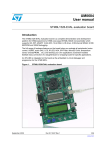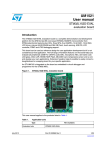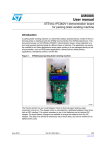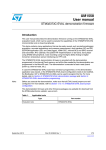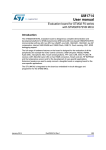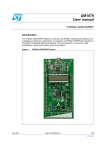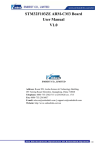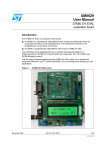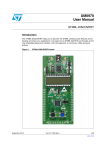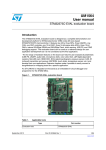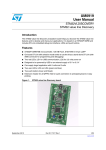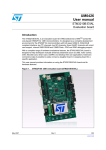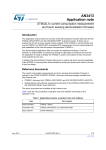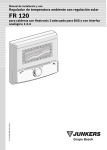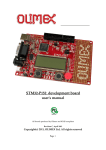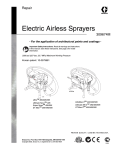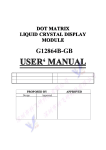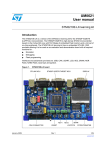Download STM32L152-EVAL evaluation board
Transcript
UM1018 User Manual STM32L152-EVAL evaluation board Introduction The STM32L152-EVAL evaluation board is a complete demonstration and development platform for STMicroelectronics’ ARM cortex-M3 core-based STM32L152VBT6 microcontroller supporting two I2C, two SPI and three USART channels, 12-bit ADC, 12-bit DAC, 16 KB internal SRAM and 128 KB Flash, USB FS, LCD controller, touch sensing and JTAG debugging support. The full range of hardware features on the board helps you evaluate all peripherals (USB FS, USART, Audio DAC, microphone ADC, dot-matrix LCD, LCD glass, IrDA, light dependant resistor (LDR), MicroSD CardTM and temperature sensor amongst others) and develop your own applications. Extension headers make it possible to easily connect a daughter board or wrapping board for your specific application. An ST-LINK/V2 is integrated on the board as embedded in-circuit debugger and programmer for the STM32 MCU. Figure 1. November 2011 STM32L152-EVAL evaluation board Doc ID 18141 Rev 2 1/10 www.st.com Contents UM01018 Contents 1 2 3 2/42 Features . . . . . . . . . . . . . . . . . . . . . . . . . . . . . . . . . . . . . . . . . . . . . . . . . . . 4 1.1 Demonstration software . . . . . . . . . . . . . . . . . . . . . . . . . . . . . . . . . . . . . . . 4 1.2 Order code . . . . . . . . . . . . . . . . . . . . . . . . . . . . . . . . . . . . . . . . . . . . . . . . . 4 Hardware and layout . . . . . . . . . . . . . . . . . . . . . . . . . . . . . . . . . . . . . . . . . 5 2.1 Development and debug support . . . . . . . . . . . . . . . . . . . . . . . . . . . . . . . . 7 2.2 Power supply . . . . . . . . . . . . . . . . . . . . . . . . . . . . . . . . . . . . . . . . . . . . . . . 7 2.3 Clock source . . . . . . . . . . . . . . . . . . . . . . . . . . . . . . . . . . . . . . . . . . . . . . . . 9 2.4 Reset source . . . . . . . . . . . . . . . . . . . . . . . . . . . . . . . . . . . . . . . . . . . . . . . 9 2.5 Boot option . . . . . . . . . . . . . . . . . . . . . . . . . . . . . . . . . . . . . . . . . . . . . . . . 10 2.6 LCD glass module . . . . . . . . . . . . . . . . . . . . . . . . . . . . . . . . . . . . . . . . . . 10 2.7 Audio . . . . . . . . . . . . . . . . . . . . . . . . . . . . . . . . . . . . . . . . . . . . . . . . . . . . 11 2.8 USB . . . . . . . . . . . . . . . . . . . . . . . . . . . . . . . . . . . . . . . . . . . . . . . . . . . . . 11 2.9 RS-232 and IrDA . . . . . . . . . . . . . . . . . . . . . . . . . . . . . . . . . . . . . . . . . . . 11 2.10 Touch sensing buttons . . . . . . . . . . . . . . . . . . . . . . . . . . . . . . . . . . . . . . . 12 2.11 MicroSD Card . . . . . . . . . . . . . . . . . . . . . . . . . . . . . . . . . . . . . . . . . . . . . . 12 2.12 Analog input . . . . . . . . . . . . . . . . . . . . . . . . . . . . . . . . . . . . . . . . . . . . . . . 12 2.13 Comparator . . . . . . . . . . . . . . . . . . . . . . . . . . . . . . . . . . . . . . . . . . . . . . . 13 2.14 Temperature sensor . . . . . . . . . . . . . . . . . . . . . . . . . . . . . . . . . . . . . . . . . 14 2.15 Display and input devices . . . . . . . . . . . . . . . . . . . . . . . . . . . . . . . . . . . . . 14 2.16 IDD measurement . . . . . . . . . . . . . . . . . . . . . . . . . . . . . . . . . . . . . . . . . . 15 2.16.1 Run mode . . . . . . . . . . . . . . . . . . . . . . . . . . . . . . . . . . . . . . . . . . . . . . . 15 2.16.2 Low power mode . . . . . . . . . . . . . . . . . . . . . . . . . . . . . . . . . . . . . . . . . . 15 2.16.3 Ibias current measurement procedure . . . . . . . . . . . . . . . . . . . . . . . . . . 17 Connectors . . . . . . . . . . . . . . . . . . . . . . . . . . . . . . . . . . . . . . . . . . . . . . . 18 3.1 RS-232 connectors (CN2, CN5) . . . . . . . . . . . . . . . . . . . . . . . . . . . . . . . . 18 3.2 TFT LCD connector (CN14) . . . . . . . . . . . . . . . . . . . . . . . . . . . . . . . . . . . 18 3.3 Power connector (CN12) . . . . . . . . . . . . . . . . . . . . . . . . . . . . . . . . . . . . . 19 3.4 Daughterboard extension connectors (CN6 and CN7) . . . . . . . . . . . . . . . 19 3.5 ST-LINK/V2 programming connector CN10 . . . . . . . . . . . . . . . . . . . . . . . 22 3.6 ST-LINK/V2 USB type B connector CN11 . . . . . . . . . . . . . . . . . . . . . . . . 23 Doc ID 18141 Rev 2 UM01018 Contents 3.7 User USB Type B connector CN1 . . . . . . . . . . . . . . . . . . . . . . . . . . . . . . 23 3.8 Audio jack CN3 . . . . . . . . . . . . . . . . . . . . . . . . . . . . . . . . . . . . . . . . . . . . . 23 3.9 JTAG connector CN9 . . . . . . . . . . . . . . . . . . . . . . . . . . . . . . . . . . . . . . . . 24 3.10 Trace debugging connector CN8 . . . . . . . . . . . . . . . . . . . . . . . . . . . . . . . 24 3.11 MicroSD Card connector CN4 . . . . . . . . . . . . . . . . . . . . . . . . . . . . . . . . . 25 3.12 BNC connector CN13 . . . . . . . . . . . . . . . . . . . . . . . . . . . . . . . . . . . . . . . . 25 4 Schematics . . . . . . . . . . . . . . . . . . . . . . . . . . . . . . . . . . . . . . . . . . . . . . . 26 5 Revision history . . . . . . . . . . . . . . . . . . . . . . . . . . . . . . . . . . . . . . . . . . . 41 Doc ID 18141 Rev 2 3/42 Features 1 UM01018 Features ● 1.1 Four 5 V power supply options: – Power jack – ST-LINK/V2 USB connector – User USB connector – Daughterboard ● Audio speaker and microphone connected to DAC and ADC of STM32L152VBT6 ● 2 GByte or more SPI interface MicroSD CardTM ● I2C compatible serial interface temperature sensor ● RS-232 communication ● IrDA transceiver ● JTAG and trace debug support, ST-LINK/V2 embedded. ● 240x320 TFT color LCD connected to SPI interface of STM32L152VBT6 ● Joystick with 4-direction control and selector ● Reset button ● Tamper or Key button ● 4 color user LEDs and 3 LEDs as MCU power range indicator ● MCU consumption measurement circuit ● LCD glass 32 x 4 segments connected to LCD controller in STM32L152VBT6 ● Extension connector for daughterboard or wrapping board ● MCU voltage choice of 3.3 V or adjustable from 1.65 V to 3.6 V ● USB FS connector ● Two touch sensing buttons ● Light dependent resistor (LDR) ● Potentiometer Demonstration software Demonstration software is preloaded in the board's Flash memory for easy demonstration of the device peripherals in stand-alone mode. For more information and to download the latest version available, please refer to the STM32L152-EVAL demonstration software available on www.st.com. 1.2 Order code To order the STM32L152VBT6 evaluation board, use the order code STM32L152-EVAL. 4/42 Doc ID 18141 Rev 2 UM01018 2 Hardware and layout Hardware and layout The STM32L152-EVAL evaluation board is designed around the STM32L152VBT6 microcontroller in a 100-pin TQFP package. Figure 1 illustrates the connections between the STM32L152VBT6 and its peripherals (color LCD, touch sensing button, USB FS connector, temperature sensor, USART, IrDA, audio, MicroSD Card and embedded ST-LINK/V2). Figure 2 helps you to locate these features on the evaluation board. Figure 1. Hardware block diagram *OYSTICK ,%$S '0)/ 7AKEUP BUTTON ,$2 30 ) -ICRO3$ #ARD 30 ) $OT-ATRIX ,#$ 6OLTAGE TRANSLATOR 23 TRANSCEIVER #OMPARATOR 53! 24 ".# CONNECTOR ,#$'LASS 43 CONTROLL ER !$# 34-,6"4 !$# ,#$ CONTROLL ER 6TO6 ADJUSTABLE REGULATOR 6REGULATOR 3PEAKER !MPLI FIER 53" &3 *4!' )# %MBEDDED 34,).+6 53" 4YPE" CONNECTOR *4!'4RACE CONNECTOR -#5 CONSUMPTION MEASUREMENT %XTENSION CONNECTORFOR '0)/S ! 4EMPERATURE SENSOR 0OTENTIOMETER -ICROPHONE !MPLI FIER $!# 53" CONNECTOR 53! 24 $"CONNECTOR )R$! TRANSCEIVER &4 4OUCH SENSING 53! 24 $"CONNECTOR Doc ID 18141 Rev 2 5/42 Hardware and layout Figure 2. UM01018 STM32L152-EVAL board layout ) % !. ! #$% ! 5#%"). # 2/ +6 2/ & '( $ - % $ 5 !1 %- ,- 8%*43) !. ! * "!# %" 8%*43) % # . ) )72, 6/42 $- % )#+, !#120/ . /0 Doc ID 18141 Rev 2 .,+ 340 UM01018 2.1 Hardware and layout Development and debug support Version 2 of the ST-LINK, called ST-LINK/V2, is embedded on the board. This tool allows on-board program loading and debugging of the STM32L using the JTAG or SWD interface. Third-party debug tools are also supported by the JTAG (CN9) or Trace (CN8) connectors. To communicate with the embedded ST-LINK/V2, a specific driver needs to be installed on your PC. To download and install this driver, refer to the Software and development tools page for the ultra low power STM32L family available on www.st.com (the install shield is called ST-LINK_V2_USBdriver.exe). The embedded ST-LINK/V2 connects to the PC via a standard USB cable from connector CN11. The bicolor LED LD5 (COM) advises on the status of the communication as follows: 1. Slow blinking Red, then Off: At power-on before USB initialization. 2. Fast blinking Red, then Off: After the first correct communication between PC and STLink/V2 (enumeration). 3. Red On: When initialization between PC and ST-LINK/V2 is successfully finished. 4. Green On: After successful target communication initialization. 5. Blinking Red/Green: During communication with target. 6. Green On: Communication finished and OK. 7. Orange On: Communication failure. Note: It is possible to power the board via CN11 (embedded ST/LINK/V2 USB connector) even if an external tool is connected to CN8 (trace) or CN9 (external JTAG and SWD). 2.2 Power supply The STM32L152-EVAL is designed to be powered by a 5 V DC power supply and to be protected by PolyZen from a wrong power plug-in event. It is possible to configure the evaluation board to use any of the following four power supply sources by setting jumpers JP12, JP13 and JP4 (see Table 1). ● Note: 5 V DC power adapter connected to CN12, the power jack on the board (power supply unit (PSU on silk screen)). The external power supply is not provided with the board but can be ordered separately. The AC220V to DC5V power adapter PSU-5V2A (recommended, can be ordered from ST order code PSU-5V2A) or equivalent (polarity compatible with CN12) can be used to power the STM32L152-EVAL board via its power jack CN12. ● 5 V DC power with 500 mA limitation from CN11, the USB type B connector of STLINK/V2 (USB 5 V power source (ST-LINK/V2 on silkscreen)). ● 5 V DC power with 500 mA limitation from CN1, the USB type B connector (5 V power source (USB on silkscreen)). ● 5 V DC power from CN6, the extension connector for daughterboard (daughterboard power source (Daughter board on JP12 silkscreen). Various LEDs indicate the power status: ● Red LED LD9 is lit when the STM32L152-EVAL board is powered correctly by 5 V. ● Red LED LD8 is lit when MCU is powered by low voltage (VDD < 1.8 V). ● Yellow LED LD7 is lit when MCU is powered by voltage (1.8 V<VDD<2.2 V). ● Green LED LD6 is lit when MCU is powered by voltage (2.2 V<VDD). Doc ID 18141 Rev 2 7/42 Hardware and layout Table 1. UM01018 Power related jumpers Jumper JP12 (selects one of the four possible power supply resources) Description Jumper setting For power supply from jack (CN12) to the STM32L152-EVAL only, JP12 is set as shown. PSU Daughter board USB STLink/V2 For power supply from daughterboard connector (CN6) to STM32L152-EVAL only, JP12 is set as shown. PSU Daughter board USB STLink/V2 For power supply from USB (CN1) to STM32L152-EVAL only, JP12 is set as shown. PSU Daughter board USB STLink/V2 For power supply from USB connector of ST-LINK/V2 (CN11) to STM32L152-EVAL only, JP12 is set as shown (default setting). PSU Daughter board USB STLink/V2 For power supply from power supply jack (CN12) to both STM32L152-EVAL and daughterboard connected on CN6 and CN7, JP12 is set as shown (daughterboard must not have its own power supply connected). PSU Daughter board USB STLink/V2 VDD is connected to fixed +3.3V DC power when JP13 is set as shown (default setting). 1 2 3 VDD is connected to adjustable DC power from 1.65 V to 3.6 V when JP13 is set as shown. 1 2 3 VDD power is directly connected to MCU VDD when JP4 is set as shown (default setting). Note: For manual IDD measurement the jumper on JP4 must be removed and replaced by an ammeter connected between pin 1 and 2 of JP4. 1 2 3 Connect VDD power to MCU with current-sampling resistor, 1 Ohm or 1 KOhm, in series for IDD current measurement when JP4 is set as shown. 1 2 3 JP13 JP4 8/42 Doc ID 18141 Rev 2 UM01018 2.3 Hardware and layout Clock source Two clock sources are available on the STM32L152-EVAL evaluation board for the STM32L152VBT6 and embedded RTC. ● X1, 32 KHz crystal for embedded RTC ● X2, 8 MHz crystal with socket for the STM32L152VBT6 microcontroller, it can be removed from the socket when an internal RC clock is used. Table 2. 32 KHz crystal X1 related solder bridges Solder bridge Description PC14 is connected to 32 KHz crystal when SB1 is open (default setting). SB1 PC14 is connected to extension connector CN6 when SB1 is closed. In such case R37 must be removed to avoid disturbance due to the 32 KHz quartz. PC15 is connected to 32 KHz crystal when SB4 is open (default setting). SB4 PC15 is connected to extension connector CN6 when SB4 is closed. In such case R38 must be removed to avoid disturbance due to the 32 KHz quartz. Table 3. 8 MHz crystal X2 related solder bridges Solder bridge Description PH1 is connected to 8 MHz crystal when SB2 is open (default setting). SB2 PH1 is connected to extension connector CN7 when SB2 is closed. In such case R39 must be removed to avoid disturbance due to the 8 MHz quartz. PH0 is connected to 8 MHz crystal when SB3 is open (default setting). SB3 2.4 PH1 is connected to extension connector CN7 when SB3 is closed. In such case C30 and X2 must be removed. Reset source The reset signal of the STM32L152-EVAL evaluation board is low active and the reset sources include: Note: ● Reset button B1 ● Debugging Tools from JTAG connector CN9 and trace connector CN8 ● Daughterboard from CN7 ● Embedded ST-LINK/V2 ● RS-232 connector CN2 for ISP Jumper JP9 must be changed for RESET. This is handled by pin8 of the RS-232 connector CN2 (CTS signal), refer to Section 2.9 for details. Doc ID 18141 Rev 2 9/42 Hardware and layout 2.5 UM01018 Boot option The STM32L152-EVAL evaluation board is able to boot from: ● Embedded user Flash ● System memory with boot loader for ISP ● Embedded SRAM for debugging The boot option is configured by setting switch SW1 (BOOT0) and SW2 (BOOT1). BOOT0 can also be configured via RS-232 connector CN2. Table 4. Boot related switches Switch Boot from STM32L152-EVAL boot from embedded user Flash when SW1 is set as shown. SW2 is not relevant in this configuration (default setting). SW1 and SW2 Table 5. 2.6 0 1 SW1 STM32L152-EVAL boot from embedded SRAM when SW1 and SW2 are set as shown. 0 STM32L152-EVAL boot from system memory when SW1 and SW2 are set as shown. 0 1 SW1 SW2 1 SW1 SW2 Boot0 related jumper JP6 Jumper JP6 Setting Description Bootloader_BOOT0 is managed by pin 6 of CN2 (RS-232 DSR signal) when JP6 is closed. This configuration is used for boot loader application only. Default setting: Not fitted. LCD glass module An LCD glass module, U20, with 8-digit liquid crystal display is mounted on the STM32L152-EVAL evaluation board and is connected to the LCD controller of the STM32L152VBT6. Table 6. Jumper LCD glass related jumpers Description Setting PC10 is connected to LCD glass as SEG40 when JP7 is set as shown (default setting). 1 2 3 PC10 is connected to USART3_TX when JP7 is set as shown. 1 2 3 PC11 is connected to LCD glass as SEG41 when JP8 is set as shown (default setting). 1 2 3 PC11 is connected to USART3_RX when JP8 is set as shown. 1 2 3 JP7 JP8 10/42 Doc ID 18141 Rev 2 UM01018 2.7 Hardware and layout Audio The STM32L152-EVAL evaluation board supports both: ● The speaker which is connected to the DAC output of the STM32L152VBT6 through an audio amplifier. ● The microphone which is connected to the ADC input of the STM32L152VBT6 through a microphone amplifier. The speaker can be enabled or disabled by setting JP16, refer to Table 7 for details. Table 7. Audio related jumpers Jumper Description Speaker amplifier U27 is enabled when JP16 is open (default setting). JP16 Speaker amplifier U27 is disabled when JP16 is closed. 2.8 USB The STM32L152-EVAL evaluation board supports USB 2.0 compliant full speed communication via a USB type B connector (CN1). The evaluation board can be powered by this USB connection at 5 V DC with 500 mA current limitation. USB disconnection simulation can be implemented by controlling the internal 1.5 K pull-up resistor on the USB D+ line to detect 5 V power on the USB connector, CN1 (using the resistor bridge that is connected to PE5). 2.9 RS-232 and IrDA Both IrDA and RS-232 (with hardware flow control CTS and RTS) communication is supported by: ● IrDA transceiver, U17 (connected to USART2 of the STM32L152VBT6 on the STM32L152-EVAL evaluation board). ● RS-232 connector, CN2 (D-type 9-pin). For ISP support, two signals are added on the RS-232 connector CN2: – Bootloader_RESET (shared with CTS signal). – Bootloader_BOOT0 (shared with DSR signal). Another RS-232 (without hardware flow control) connector, CN5, is connected to USART3 of the STM32L152VBT6. Table 8. Jumper RS-232 and IrDA related jumpers Description Setting USART2_RX is connected to RS-232 transceiver and RS-232 communication is enabled when JP5 is set as shown (default setting). 1 2 3 USART2_RX is connected to IrDA transceiver and IrDA communication is enabled when JP5 is set as shown. 1 2 3 JP5 Doc ID 18141 Rev 2 11/42 Hardware and layout Table 8. UM01018 RS-232 and IrDA related jumpers (continued) Jumper Description Setting USART2_CTS is connected to RS-232 transceiver when JP9 is set as shown (default setting). 1 2 3 Bootloader_RESET is connected to RS-232 transceiver when JP9 is set as shown. 1 2 3 JP9 JP7,JP8 Refer to Table 6 for USART3 settings. JP6 2.10 See Table 5 for Bootloader_BOOT0 settings. Touch sensing buttons The STM32L152-EVAL evaluation board supports two touch sensing buttons based on either charge transfer technology (default) or RC charging. RC charging technology can be enabled by modifying the board: 2.11 1. Remove R29. 2. Mount resistors R22 (1 MOhm), R23 (1 MOhm), R24 (10 KOhm) and C18(1 nF). MicroSD Card The 2 GB (or more) MicroSD Card connected to SPI2 port of the STM32L152VBT6 is available on the board. MicroSD Card detection is managed by standard I/O port PE6. Note: JP2 must be kept on open for trace purposes (connected to CN8). Table 9. MicroSD Card related jumpers Jumper Description PE6 is connected to MicroSD Card detection when JP2 is closed (default setting). JP2 2.12 PE6 is disconnected from MicroSD Card detection but remains connected to trace connector CN8 when JP2 is open. Analog input A BNC connector, CN13, is connected to PA5 of the STM32L152VBT6 as external analog input or DAC output. The 50 ohm terminal resistor can be enabled by closing the solder bridge SB5. A low pass filter can be implemented for the BNC connector by replacing R47 and C31 for ADC input or replacing R45 and C31 for DAC output with the values requested by end user's application. There are also 3 analog signals available on the board: 12/42 1. 10 KOhm potentiometer RV3 connected to PB12. 2. IDD measurement output signal connected to PA5 for MCU power consumption test. 3. External ADC input which can be connected to TP3 (AIN+) and TP2 (AIN-), R48 should be removed to reduce the noise on this analog input. Doc ID 18141 Rev 2 UM01018 2.13 Hardware and layout Comparator Three I/Os are used to implement a comparator feature as shown in Figure 3. Figure 3. ● Comparator non-inverting input PB4 connected to LDR (R34). ● Comparator inverting input PB3 connected to potentiometer (RV3) used as variable threshold input for comparison to luminosity measured on LDR. ● Comparator non-inverting input PB5 connected to potentiometer (RV3) used as analogue voltage input for comparison with internal voltage reference (for instance Band gap) in order to test analogue Wakeup feature of the MCU. STM32L152-EVAL comparator features 6$$ ,$2?/54 '0COMPARATOR ,$2 '.$ 6$$ 26 '.$ *0 0" '0#/-0?). 0" '0#/-0?). 0" '0#/-0?). 0" !$#?). )#!0 "ANDGAP6 -36 Jumper JP17 allows 3 different usages of the potentiometer as shown in Table 10. Table 10. Jumper JP17 Comparator and potentiometer related jumpers Description Setting Potentiometer RV3 is connected to ADC input PB12. Used as ADC input when JP17 is set as shown (default setting). PB12 PB3 PB5 Potentiometer RV3 used as LDR variable threshold. Input is connected to comparator inverting input GPCOMP_IN- (PB3) when JP17 is set as shown. PB12 PB3 PB5 Potentiometer RV3 is connected to non-inverting input GPCOMP_IN+(PB5). The comparator inverting input can be connected to ¼ band gap, ½ band gap, band gap or DAC internally to test MCU wakeup possibility when an external voltage reaches a programmable threshold when JP17 is set as shown. PB12 PB3 PB5 PB4 is connected to JTAG connector CN9 (TRST) when JP10 is set as shown (default setting). 1 2 3 PB4 is connected to LDR when JP10 is set as shown. 1 2 3 JP10 Doc ID 18141 Rev 2 13/42 Hardware and layout Table 10. UM01018 Comparator and potentiometer related jumpers (continued) Jumper Description Setting PB5 is connected to I2C_SMB, the interrupt output of temperature sensor U18 when JP11 is closed (default setting). JP11 PB5 is disconnected from I2C_SMB but remains connected to COM_IN+ when JP11 is open for comparator application. 2.14 Temperature sensor A temperature sensor STLM75M2E is connected to the I2C bus of the STM32L152VBT6 through two transistors to support a wide voltage range, from 1.65 V to 3.6 V. 2.15 Display and input devices The display devices are: ● 2.4" color TFT LCD, connected to the SPI1 port of the STM32L152VBT6. ● 4 general purpose color LED's (LD 1,2,3,4). LD3 and LD4 are disabled by default; JP18 and JP19 must be closed to enable these two LEDs. The input devices are: ● 4-direction joystick (U30) with selection key ● Wakeup button (B2) Table 11. 2.4" TFT LCD module CN14 Pin on CN3 14/42 Description Pin connection 1 CS PH2 2 SCL PE13 3 SDI PE15 4 RS - 5 WR - 6 RD - 7 SDO PE14 8 RESET RESET# 9 VDD 3.3V 10 VCI 3.3V 11 GND GND 12 GND GND 13 BL_VDD 5V 14 BL_Control 5V 15 BL_GND GND 16 BL_GND GND Doc ID 18141 Rev 2 UM01018 2.16 Hardware and layout IDD measurement The built-in IDD measurement circuit implemented allows the consumption measurement of the STM32L152C6T6 while the MCU is in Run or Low power saving modes. For IDD measurement the circuit below is implemented on STM32L152-EVAL. Figure 4. STM32L152-EVAL IDD measurement circuit " !1 5?&&#@!4 A $ # # $ *3; ( ;3* ) ## " :" 14 " ) $% )(4 # # " # # ( $ 1: ) !& $% )(1$4 " <=> $ ) :1 1: # $ " @ ! B B B# B" B$ B B# ( ) B& B B@ 5 $%)$11:9 11 " $ # 1 & @ "4 *794!: ) 14 *75 , ) " ( 4<=> #" $ # $ ) ! ':$ # )75! :# *77 #14 ;-- C D0 #14EF 2.16.1 -36 Run mode In Run mode, IDD current is measured using the operational amplifier MAX9938FEUK+ (U10) connected to the 1 Ohm shunt resistor (R36). In this case IDD_CNT_EN remains high during measurement, so R35 remains in shortcircuit during the measurement because of transistor T4 which remains ON permanently. Jumper JP4 must be connected between pins 2 and 3. 2.16.2 Low power mode In Low power modes (Stop or Standby), the operational amplifier MAX9938FEUK+ (U10) is connected to the 1 KOhm shunt resistor (R35), controlled by the analogue switch T4. In this case the counter 74HC4060 (U6) enabled by IDD_CNT_EN manages the measurement timing according to Figure 5. Doc ID 18141 Rev 2 15/42 Hardware and layout Figure 5. UM01018 STM32L152-EVAL IDD low power modes measurement timing diagram Wake-up period IDD measurement Wake-up event MCU mode Run Clear CNT event Stop or Standby 5 IDD_CNT_EN (PB15) Q12 = LOW_POWER_EN (T4 pin 3) Q13 = IDD_WAKEUP (PC13) Q13n = disconnect filter (U7 pin 4) 3 6 4 0 ms 150 ms 300 ms The principle used to measure a current when the STM32L is in Low power mode is: 1. Configure ADC to measure voltage on the IDD_Measurement pin (PA5). 2. Configure PA0 to serve as wakeup pin. 3. Enter Low power mode after setting IDD_CNT_EN signal low. 4. IDD_WAKEUP rising edge wakes up the MCU after around 300 ms. 5. Start ADC conversion as soon as possible after wakeup in order to measure the voltage corresponding to Low power mode on capacitor C25. 6. Reset the counter by programming IDD_CNT_EN high (in less than 70 ms after the wakeup) to avoid the R35 (1 KOhm) resistor being connected later in Run mode. In Low power modes, the 1 KOhm resistor is connected when T4 goes off after entering Low power mode. Q12 output of the counter allows connection of the 1 K resistor when the current IDD becomes very low. Figure 5 shows how the counter and T4 ensure that, 150 ms after IDD_CNT_EN falling edge, the shunt resistor R35 is connected between VDD_MCU and the power supply in order to reduce the measurement range to 30 uA full scale when VDD = 1.8 V. Then after another 150 ms for current stabilization, R35 is shorted, the IDD measurement is stored in C25, and the MCU is woken up. After wakeup the MCU can measure the IDD current corresponding to the Low power mode stored in C25. Note: 16/42 It is recommended to maintain VDD on the STM32L at a value lower than 3.5 V during low power current measurement to avoid extra current consumption on the NRST pin (U11 pin 14). The reason for this is that the NRST pin of the STM32L is connected to the ST-LINK MCU T_NRST signal (U23 pin 18), and as the ST-LINK is powered at 3.3 V a leakage current is injected into the STM32L NRST pin when MCU VDD becomes equal to or greater than 3.5 V. Doc ID 18141 Rev 2 UM01018 2.16.3 Hardware and layout Ibias current measurement procedure In Low power mode the bias current of operational amplifier input (U10 pin 4) is not negligible compared to IDD current (typical Ibias is ~240 nA). To obtain a reliable MCU IDD measurement it is possible to subtract the bias current from the IDD low power measurement since this current is not sinked by the MCU. The procedure for accurate IDD measurement is: 1. Set jumper on JP4 pins 1 and 2. 2. Follow the Low power mode procedure to measure I1 = I bias. 3. Remove jumper on JP4 pins 1 and 2 and place it on JP4 pins 2 and 3. 4. Follow the low power mode procedure to measure I2 = IDD + I bias. 5. Calculate actual IDD: IDD = I2 - I1. Table 12. Jumper IDD measurement related jumpers Description Setting PA5 is connected to IDD_measurement, the output of IDD measurement circuit when JP14 is closed (default). JP14 PA5 is disconnected from IDD_measurement but remains connected to BNC connector CN13 when JP14 is open. STM32L is powered through IDD measurement circuit (default) 1 2 3 STM32L is powered directly by +3V3, IDD measurement circuit is bypassed. Please refer to Section 2.2: Power supply for details. 1 2 3 JP4 Note: When jumper JP4 is removed the current consumption of the STM32L can be measured by connecting an ammeter between jumper JP4 pin 1 and pin 2. Note: RDS (on) typical value of analog switch T4 = 50 micro Ohm, so to improve measurement accuracy it is recommended to take into account the RDS in series with R36 (1 Ohm) in the Idd Run mode current calculation. Doc ID 18141 Rev 2 17/42 Connectors UM01018 3 Connectors 3.1 RS-232 connectors (CN2, CN5) Figure 6. RS-232 connector (viewed from front) -36 Table 13. RS-232 connector CN2 with HW flow control and ISP support Pin number Description Pin number 1 6 Bootloader_BOOT0 2 RS-232_RX (PD6) 7 RS-232_RTS(PD4) 3 RS-232_TX (PD5) 8 RS-232_CTS(PD3)/Bootloader_RESET 4 NC 9 NC 5 GND Table 14. RS-232 connector CN5 Pin number 3.2 Description Description Pin number Description 1 NC 6 Connected to pin4 2 RS-232_RX (PC11) 7 Connected to pin8 3 RS-232_TX (PC10) 8 Connected to pin7 4 Connected to pin6 9 NC 5 GND TFT LCD connector (CN14) A TFT color LCD board (MB895) is mounted on CN14. 18/42 Doc ID 18141 Rev 2 UM01018 3.3 Connectors Power connector (CN12) Your STM32L152-EVAL evaluation board can be powered from a DC 5 V power supply via the external power supply jack (CN12) shown in Figure 7. The central pin of CN12 must be positive. Figure 7. Power supply connector CN12 (viewed from front) $#6 '.$ -36 3.4 Daughterboard extension connectors (CN6 and CN7) Two 50-pin male headers CN6 and CN7 can connect a daughterboard or standard wrapping board to the STM32L152-EVAL evaluation board. All GPIOs are available on it. The space between these two connectors and position of power, GND and RESET pins are defined as a standard which allows common daughterboards to be developed for several evaluation boards. The standard width between CN6 pin1 and CN7 pin1 is 2700 mils (68.58 mm). This standard is implemented on the majority of evaluation boards. Each pin on CN6 and CN7 can be used by a daughterboard after disconnecting it from the corresponding function block on the STM32L152-EVAL evaluation board. Please refer to Table 15 and Table 16 for details. Table 15. Daughterboard extension connector CN6 Pin Description Alternative function How to disconnect with function block on STM32L152-EVAL board 1 GND - - 3 PC7 TS_KEY2 Remove R13 5 PC9 TS_CT Remove R29 7 PA9 COM1 Remove LCD glass U20 9 PA0 Tamper/Key - 11 PC14 32K OSC Remove R37 13 PA12 USB DP Remove R25 15 PC15 32K OSC Remove R38 17 PC10 LCD glass_SEG40 / USART3_TX JP7 open 19 GND - - 21 PC12 LCD glass_SEG42 Remove LCD glass U20 23 PD1 LED2 Remove R125 Doc ID 18141 Rev 2 19/42 Connectors UM01018 Table 15. Daughterboard extension connector CN6 (continued) Pin Description 20/42 Alternative function How to disconnect with function block on STM32L152-EVAL board 25 PD3 USART2_CTS JP9 open 27 PD5 USART2_TX / LED4 JP19 open 29 PD7 CS_uSD Remove SD card from CN4 31 VLCD - - 33 PB3 JTDO / COMP_POT- JP17 open 35 PB5 TEMP_SMBAI / COMP_POT+ JP17 and JP11 open 37 PB7 I2C_TEMP_SDA Remove R62 39 GND - - 41 PE2 LCD glass_SEG38 / TRACE_CLK Remove LCD glass U20 43 PE4 TRACE_D1 - 45 PB8 LCD glass_SEG16 Remove LCD glass U20 47 PE6 TRACE_D3 / SD Card detection JP2 open 49 D5V - - 2 PC6 TS_KEY1 Remove R14 4 PC8 TS_SHIELD - 6 PA8 LCD glass_COM0 Remove LCD glass U20 8 PA10 LCD glass_COM2 Remove LCD glass U20 10 GND - - 12 PA11 USB DM Remove R16 14 PA13 JTMS - 16 PA14 JTCK - 18 PC11 LCD glass_SEG41 / USART3_RX JP8 open 20 PA15 JTDI - 22 PD0 LED1 Remove R111 24 PD2 LCD glass_SEG43 Remove LCD glass U20 26 PD4 USART2_RTS/ LED3 JP18 open 28 PD6 USART2_RX Remove R19 30 GND - - 32 PH2 CS_LCD - 34 PB4 JTRST / LDR JP10 open 36 PB6 I2C_TEMP_SCL Remove R69 38 PE0 LCD glass_SEG36 Remove LCD glass U20 40 PE1 LCD glass_SEG37 Remove LCD glass U20 42 PE3 LCD glass_SEG39 / TRACE_D0 Remove LCD glass U20 Doc ID 18141 Rev 2 UM01018 Connectors Table 15. Daughterboard extension connector CN6 (continued) Pin Description Alternative function How to disconnect with function block on STM32L152-EVAL board 44 PE5 TRACE_D2 - 46 PB9 LCD glass_COM3 Remove LCD glass U20 48 +3V3 - - 50 GND - - Table 16. Daughterboard extension connector CN7 Pin Description How to disconnect with function block on STM32L152-EVAL board Alternative function 1 GND - - 3 PD14 LCD glass_SEG34 Remove LCD glass U20 5 PD12 LCD glass_SEG32 Remove LCD glass U20 7 PD10 LCD glass_SEG30 Remove LCD glass U20 9 PC13 IDD_CNT_EN - 11 RESET# - - 13 PB15 uSD_SPI2_MOSI - 15 PB13 uSD_SPI2_SCK - 17 PB11 LCD glass_SEG11 Remove LCD glass U20 19 D5V 21 PE14 LCD_SPI1_MISO Remove R57 23 PH0 OSC_IN Remove X2 from socket and close SB3 25 PE12 JOYSTICK_LEFT Remove R118 27 PE10 JOYSTICK_DOWN Remove R127 29 PE8 JOYSTICK_SEL Remove R112 31 PE7 Audio_IN Remove R75 33 PB1 LCD glass_SEG6 Remove LCD glass U20 35 PC5 LCD glass_SEG23 Remove LCD glass U20 37 PA7 LCD glass_SEG4 Remove LCD glass U20 39 GND - - 41 PA4 Audio_DAC1_out Remove R103 43 PA2 LCD glass_SEG1 Remove LCD glass U20 45 PC3 LCD glass_SEG21 Remove LCD glass U20 47 PC1 LCD glass_SEG19 Remove LCD glass U20 49 PC13 IDD_CNT_EN - 2 PD15 LCD glass_SEG35 Remove LCD glass U20 - Doc ID 18141 Rev 2 21/42 Connectors UM01018 Table 16. Daughterboard extension connector CN7 (continued) Pin Description 3.5 How to disconnect with function block on STM32L152-EVAL board Alternative function 4 PD13 LCD glass_SEG33 Remove LCD glass U20 6 PD11 LCD glass_SEG31 Remove LCD glass U20 8 PD9 LCD glass_SEG29 Remove LCD glass U20 10 GND - - 12 PD8 LCD glass_SEG28 Remove LCD glass U20 14 PB14 uSD_SPI2_ - 16 PB12 POT_ADC18 JP17 open 18 PB10 LCD glass_SEG10 Remove LCD glass U20 20 PE15 LCD_SPI1_MOSI - 22 PE13 LCD_SPI1_SCK - 24 PH1 OSC_OUT Remove X2 from socket and close SB2 26 PE11 JOYSTICK_RIGHT Remove R117 28 PE9 JOYSTICK_UP Remove R126 30 GND - - 32 PB2 BOOT1 / TS_LOAD - 34 PB0 LCD glass_SEG5 Remove LCD glass U20 36 PC4 LCD glass_SEG22 Remove LCD glass U20 38 PA6 LCD glass_SEG3 Remove LCD glass U20 40 PA5 BNC JP14 open 42 PA3 LCD glass_SEG2 Remove LCD glass U20 44 PA1 LCD glass_SEG0 Remove LCD glass U20 46 PC2 LCD glass_SEG20 Remove LCD glass U20 48 PC0 LCD glass_SEG18 Remove LCD glass U20 50 GND - - ST-LINK/V2 programming connector CN10 Connector CN10 is used only for embedded ST-LINK/V2 programming during board manufacture. It is not populated by default and is not for end user usage. 22/42 Doc ID 18141 Rev 2 UM01018 3.6 Connectors ST-LINK/V2 USB type B connector CN11 The USB connector, CN11, is used to connect the embedded ST-LINK/V2 to the PC for board debugging. Figure 8. USB type B connector CN11 (viewed from front) -36 Table 17. USB type B connector CN11 Pin number 3.7 Description 1 VBUS (power) 2 DM 3 DP Pin number Description 4 GND 5,6 Shield User USB Type B connector CN1 Figure 9. USB type B connector CN1 (viewed from front) -36 Table 18. USB type B connector CN1 Pin number 3.8 Description Pin number Description 1 VBUS (power) 4 GND 2 DM 5 Shield 3 DP 6 Shield Audio jack CN3 A 3.5 mm stereo audio jack, CN3, connected to audio DAC is available. Doc ID 18141 Rev 2 23/42 Connectors 3.9 UM01018 JTAG connector CN9 Figure 10. JTAG debugging connector CN9 (viewed from above PCB) -36 Table 19. JTAG debugging connector CN9 Pin number 3.10 Description Pin number Description 1 3.3 V power 2 3.3 V power 3 PB4 4 GND 5 PA15 6 GND 7 PA13 8 GND 9 PA14 10 GND 11 RTCK 12 GND 13 PB3 14 GND 15 RESET# 16 GND 17 DBGRQ 18 GND 19 DBGACK 20 GND Trace debugging connector CN8 This is the same connector type as CN9 (see Figure 10). Table 20. Trace debugging connector CN8 Pin number 24/42 Description Pin number Description 1 3.3V power 2 TMS/PA13 3 GND 4 TCK/PA14 5 GND 6 TDO/PB3 7 KEY 8 TDI/PA15 9 GND 10 RESET# 11 GND 12 TraceCLK/PE2 13 GND 14 TraceD0/PE3 or SWO/PB3 15 GND 16 TraceD1/PE4 or nTRST/PB4 17 GND 18 TraceD2/PE5 19 GND 20 TraceD3/PE6 Doc ID 18141 Rev 2 UM01018 3.11 Connectors MicroSD Card connector CN4 Figure 11. MicroSD Card connector CN4 (viewed from front) -36 Table 21. MicroSD Card connector CN4 Pin number Description Pin number 1 5 MicroSDcard_CLK (PB13) 2 MicroSDcard_CS (PD7) 6 Vss/GND 3 MicroSDcard_DIN(PB15) 7 MicroSDcard_DOUT(PB14) 4 +3V3 8 9 3.12 Description MicroSDcard_detect (PE6) BNC connector CN13 Figure 12. Analog input connector CN13 (viewed from bottom) -36 Table 22. Analog input connector CN13 Pin number Description Pin number Description 1 GND 4 GND 2 GND 5 Analog input PA5 3 GND Doc ID 18141 Rev 2 25/42 Schematics 4 UM01018 Schematics The following schematics are listed. 26/42 ● Figure 13: STM32L152-EVAL on page 27 ● Figure 14: MCU on page 28 ● Figure 15: LCD glass on page 29 ● Figure 16: Audio on page 30 ● Figure 17: Peripherals on page 31 ● Figure 18: Power on page 32 ● Figure 19: Extension connector on page 33 ● Figure 20: LCD and SD Card on page 34 ● Figure 21: RS-232 and IrDA on page 35 ● Figure 22: IDD_Measurement on page 36 ● Figure 23: Temperature sensor on page 37 ● Figure 24: ST-LINK on page 38 ● Figure 23: Temperature sensor on page 37 ● Figure 26: Touch sensing on page 40 Doc ID 18141 Rev 2 UM01018 Figure 13. STM32L152-EVAL 1 2 3 U_MCU MCU.SchDoc U_LCD_Glass LCD_Glass.SCHDOC A SEG[0..43] COM[0..3] SEG[0..43] COM[0..3] Audio_IN Audio_OUT Audio_IN Audio_OUT U_Audio Audio.SchDoc U_Extension connector Extension connector.SCHDOC RESET# PH[0..2] PE[0..15] PD[0..15] PC[0..15] PB[0..15] PA[0..15] RESET# PH[0..2] PE[0..15] PD[0..15] PC[0..15] PB[0..15] PA[0..15] U_IDD_measurement IDD_measurement.SchDoc Doc ID 18141 Rev 2 B IDD_Measurement IDD_WAKEUP IDD_CNT_EN IDD_CNT_EN U_TemSensor TemSensor.SCHDOC I2C_SMB I2C_SDA I2C_SLK I2C_SMB I2C_SDA I2C_SLK U_RS232_IrDA RS232_IrDA.SCHDOC USART2/IrDA_CTS Bootloader_RESET Bootloader_BOOT0 USART2/IrDA_RX USART3_RX USART3_TX USART2/IrDA_RTS USART2/IrDA_TX C U_LCD_MicroSD LCD_MicroSD.SchDoc SPI1_MISO SPI1_MOSI SPI1_SCK LCD_CS SPI2_MISO SPI2_MOSI SPI2_SCK MicroSD_CS SDcard_detect RESET# U_Touch Sensing Touch Sensing.SchDoc TS_LOAD TS_SHIELD TS_CT TS2 TS1 TS_LOAD TS_SHIELD TS_CT TS2 TS1 A U_Peripherals Peripherals.SchDoc BNC LED4 LED3 LED1 LED2 USB_DM USB_DP COM_IN+ COM_INWAKEUP LDR_OUT JOY_UP JOY_RIGHT JOY_LEFT JOY_DOWN JOY_SEL Potentiometer BNC LED4 LED3 LED1 LED2 IDD_Measurement USB_DM USB_DP COM_IN+ COM_INWAKEUP LDR_OUT JOY_UP JOY_RIGHT JOY_LEFT JOY_DOWN JOY_SEL Potentiometer B U_JTAG&Trace JTAG&Trace.SchDoc TDO/SWO USART2/IrDA_CTS Bootloader_RESET Bootloader_BOOT0 USART2/IrDA_RX USART3_RX USART3_TX USART2/IrDA_RTS USART2/IrDA_TX 4 TDO/SWO TRACE_D3 TRACE_D2 TRACE_D1 TRACE_D0 TRACE_CK TCK/SWCLK TMS/SWDIO TRST TDI RESET# TRACE_D3 TRACE_D2 TRACE_D1 TRACE_D0 TRACE_CK TCK/SWCLK TMS/SWDIO TRST TDI C U_ST_LINK ST_LINK.SCHDOC SPI1_MISO SPI1_MOSI SPI1_SCK LCD_CS SPI2_MISO SPI2_MOSI SPI2_SCK MicroSD_CS SDcard_detect TDO/SWO TRST TDI TCK/SWCLK TMS/SWDIO RESET# Note1:All text in the each sheet is in Italic format to be different with Net label. Note2:Version upgrade from B.1 to B.2 due to FDC606 used for T3 and T4 instead of STT5PF20V. Note3:Version upgrade from B.3 to B.4 to correct comments on italic for LD3&LD4 on sheet 5. U_Power Power.SchDoc D D STMicroelectronics Title: STM32L152-EVAL 1 2 3 Rev: B.4(PCB.SCH) Date: 9/7/2011 Sheet 1 4 of 14 27/42 Schematics Number:MB819 1 2 3 Schematics 28/42 Figure 14. MCU 4 PA[0..15] C28 6.8pF WAKEUP R43 2 10K 09.03290.01 TS_LOAD 1 LDR_OUT SEG0 SEG1 SEG2 Audio_OUT BNC SEG3 SEG4 COM0 COM1 COM2 JP10 2 USB_DM USB_DP TMS/SWDIO TCK/SWCLK TDI 3 TRST COM_INCOM_IN+ TDO/SWO JP11 I2C_SLK I2C_SDA SEG16 COM3 SEG10 SEG11 Potentiometer SPI2_SCK SPI2_MISO SPI2_MOSI X2 8MHz (with socket) C PA0 PA1 PA2 PA3 PA4 PA5 PA6 PA7 PA8 PA9 PA10 PA11 PA12 PA13 PA14 PA15 23 24 25 26 29 30 31 32 67 68 69 70 71 72 76 77 PB0 PB1 PB2 PB3 PB4 PB5 PB6 PB7 PB8 PB9 PB10 PB11 PB12 PB13 PB14 PB15 35 36 37 89 90 91 92 93 95 96 47 48 51 52 53 54 PH2 PH0 PH1 LCD_CS C30 20pF 73 12 13 14 94 C33 R39 0 PC15-OSC32_OUT PC14-OSC32_IN PC13-ANTI_TAMP PC12 PC11 PC10 PC9 PC8 PC7 PC6 PC5 PC4 PC3 PC2 PC1 PC0 PB0 PB1 PB2 PB3 PB4 PB5 PB6 PB7 PB8 PB9 PB10 PB11 PB12 PB13 PB14 PB15 PD15 PD14 PD13 PD12 PD11 PD10 PD9 PD8 PD7 PD6 PD5 PD4 PD3 PD2 PD1 PD0 PH2 PH0-OSC_IN PH1-OSC_OUT NRST BOOT0 JP6 2 20pF PA0-WKUP PA1 PA2 PA3 PA4 PA5 PA6 PA7 PA8 PA9 PA10 PA11 PA12 PA13 PA14 PA15 R32 10K B1 2 4 SW1 09.03290.01 3 3 1 1 Doc ID 18141 Rev 2 SEG5 SEG6 B I2C_SMB RESET C85 R137 D [N/A] 100nF RESET# 1 C29 6.8pF X1 R37 MC306-G-06Q-32.768 (manufacturer JFVNY) 0 R38 0 U11A 3 2 4 COM[0..3] COM[0..3] A VDD 1 SW2 3 VDD D1 BAT60JFILM PC15 PC14 PC13 PC12 PC11 PC10 PC9 PC8 PC7 PC6 PC5 PC4 PC3 PC2 PC1 PC0 62 61 60 59 58 57 56 55 88 87 86 85 84 83 82 81 PD15 PD14 PD13 PD12 PD11 PD10 PD9 PD8 PD7 PD6 PD5 PD4 PD3 PD2 PD1 PD0 46 45 44 43 42 41 40 39 38 5 4 3 2 1 98 97 U5V R138 150 PE15 PE14 PE13 PE12 PE11 PE10 PE9 PE8 PE7 PE6 PE5 PE4 PE3 PE2 PE1 PE0 R86 100K SEG42 IDD_CNT_EN 3 PH[0..2] PA[0..15] PB[0..15] PC[0..15] A PD[0..15] PE[0..15] PH[0..2] 1 SEG23 SEG22 SEG21 SEG20 SEG19 SEG18 TS_CT TS_SHIELD TS2 TS1 JP8 3 USART3_TX 2 1 JP7 SEG40 SEG41 SEG35 SEG34 SEG33 SEG32 SEG31 SEG30 SEG29 SEG28 B LED4 LED3 JP19 JP18 MicroSD_CS USART2/IrDA_RX USART2/IrDA_TX USART2/IrDA_RTS SEG43 USART2/IrDA_CTS VREF+ VDDA R41 LED2 LED1 50 SPI1_MOSI SPI1_MISO SPI1_SCK JOY_LEFT JOY_RIGHT JOY_DOWN JOY_UP JOY_SEL Audio_IN R88 0 R81 VDD_MCU BEAD SDcard_detect JP2 TRACE_D0 TRACE_CK R78 R77 SEG39 SEG38 SEG[0..43] C27 100nF U11B TRACE_D3 SEG37 SEG36 TP1 VREF 21 22 50 C34 75 C32 1uF 100nF 100 28 11 VDD_MCU 6 VLCD L1 TRACE_D2 TRACE_D1 VREF- VREF+ VDDA VDD_1 VDD_2 VDD_3 VDD_4 VDD_5 VLCD VREFVSSA VSS_1 VSS_2 VSS_3 VSS_4 VSS_5 20 19 49 74 99 27 10 C R40 0 C22 Scorpio 1uF VDD_MCU 0 0 C21 C26 C24 C17 C23 100nF 100nF 100nF 100nF 100nF SEG[0..43] 220K D STMicroelectronics Bootloader_BOOT0 Title: STM32L152-EVAL MCU Number:MB819 2 PD[0..15] USART3_RX 2 Bootloader_RESET 1 PC[0..15] PE[0..15] STM32L152VBT6 VDD D2 BAT60JFILM PE15 PE14 PE13 PE12 PE11 PE10 PE9 PE8 PE7 PE6 PE5 PE4 PE3 PE2 PE1 PE0 9 8 7 80 79 78 66 65 64 63 34 33 18 17 16 15 PB[0..15] 3 Rev: B.4(PCB.SCH) Date: 9/7/2011 Sheet 2 of 14 4 UM01018 SEG40 SEG41 SEG36 SEG37 SEG32 SEG33 SEG28 SEG29 SEG20 SEG21 SEG11 SEG16 SEG4 SEG5 SEG0 SEG1 COM3 COM2 1 2 3 4 5 6 7 8 9 10 11 12 13 14 15 16 17 18 S28 S29 S24 S25 S20 S21 S16 S17 S12 S13 S8 S9 S4 S5 S0 S1 COM4 COM3 S31 S30 S27 S26 S23 S22 S19 S18 S15 S14 S11 S10 S7 S6 S3 S2 COM1 COM2 Doc ID 18141 Rev 2 1 B 36 35 34 33 32 31 30 29 28 27 26 25 24 23 22 21 20 19 SEG43 SEG42 SEG39 SEG38 SEG35 SEG34 SEG31 SEG30 SEG23 SEG22 SEG19 SEG18 SEG10 SEG6 SEG3 SEG2 COM0 COM1 UM01018 Figure 15. LCD glass 1 2 SEG[0..43] 2 3 SEG[0..43] D 3 4 A A COM[0..3] COM[0..3] U20 PD878-DP-FH-W-LV-6-RH B C C STMicroelectronics Number:MB819 Rev: B.4(PCB.SCH) D Title: STM32L152-EVAL LCD Glass 4 Sheet 3 of 29/42 Schematics Date: 9/7/2011 14 1 2 3 Schematics 30/42 Figure 16. Audio 4 A A C74 Speaker+3V3 JP16 Audio_OUT PA4 R103 R109 10K U27 1 4 3 2 C71 R110 22K 470nF 0 C70 [N/A] 2 1 CN3 330pF R121 1 10 2 22K Standby VINVIN+ Bypass VOUT1 VOUT2 VCC GND U25 KDMG15008-03 ST-613 5 8 6 7 Speaker+ +3V3 C66 1uF C83TS4990IST 1uF B VDD C67 R99 1K R128 100 R106 2K2 C75 TP8 MIC+ 1 100nF C72 47pF TP9 MIC_OUT U28 TS461CLT 3 R108 0 R75 0 PE7 4 1 VDD C Audio_IN C69 [N/A] 2 C 10uF 5 +3V3 U29 KECG2740TBL 2 1 RV1 [N/A] C82 R98 100K R101 R129 18K R135 680 2 3 Doc ID 18141 Rev 2 B C68 4.7uF 15K R100 100K C73 2.2uF 180pF R107 82K C84 4.7uF D D STMicroelectronics Title: STM32L152-EVAL Audio Number:MB819 1 2 3 Rev: B.4(PCB.SCH) Date: 9/7/2011 Sheet 4 of 14 4 UM01018 UM01018 Figure 17. Peripherals 2 3 A BNC R45 PA5 R47 0 0 C31 [N/A] R48 0 JP14 LD3 Red 1 R131 SB5 R42 50 R123 2 PD1 R130 2 1 0 +3V3 +3V3 LED2 R9 1K R124 0 PD4 U1A TS3702IPT 2 +3V3 R122 0 PD5 R6 1K2 LED4 LEDs R5 1K BNC connector 5 B PB12 PB3 PB5 6 4 2 3 1 2 1 R120 5 3 1 LD6 Green TS3702IPT VDD>2.2V B2 WKUP C81 [N/A] JP17 Potentiometer COM_INCOM_IN+ R4 2K 100 RV3 210K 3 Doc ID 18141 Rev 2 R34 VT9ON1 6 R133 VDD VDD 4 8.2K R2 510 B 2 R53 0 1 R96 7 R134 220K 330 PA0 PB4 LD7 Orange 1.8V<VDD<2.2V R1 510 U1B VDD VDD LDR_OUT R3 VDD<1.8V 510 1 LED3 680 LD8 Red A VDD 3 680 IDD_Measurement Close to MCU on PCB R125 LED1 680 VB334 LD4 Blue 1 PD0 510 LD2 Orange 1 2 1 2 3 4 5 0 2 CN13 R111 1 TP3 AIN+ +3V3 R136 2 TP2 AIN- 4 8 +3V3 LD1 Green 1 2 4 1 WAKEUP Header 3X2 WKUP/TAMPER Button Potentiometer/Comparator Low Voltage LED R132 U30 5 COMMON 100 VDD 2 Selection R113 10K R115 10K R119 10K R116 10K R114 10K C C U5V 100nF 100nF 3 1 4 6 C77 USB_DM USB_DP 0 0 0 0 0 100nF 0 PA11 0 PA12 R112 R127 R118 R117 R126 C79 R16 R25 PE8 PE10 PE12 PE11 PE9 C80 USBLC6-2P6 (optional) JOY_SEL JOY_DOWN JOY_LEFT JOY_RIGHT JOY_UP C5 100nF 100nF 6 5 4 100nF I/O1 Vbus I/O2 C78 I/O1 GND I/O2 C76 U7 1 2 3 U5V CN1 USB-typeB connector 1 VCC 2 D3 D+ 4 GND 0 SHELL 0 SHELL DWON LEFT RIGHT UP MT008-A R27 C13 1M 4.7nF Joystick D D STMicroelectronics Title: STM32L152-EVAL Peripherals USB 1 2 3 Rev: B.4(PCB.SCH) Date: 9/7/2011 Sheet 5 4 of 14 31/42 Schematics Number:MB819 1 2 3 Schematics 32/42 Figure 18. Power 4 A A U26 ZEN056V130A24LS 1 1 3 2 Z1 SMAJ5.0A-TR 2 DC-10B C61 100nF SV SG CV 4 5 6 CG1 CG2 CG3 3 C58 220uF TP6 +3V3 U22 LD1086D2M33 +5V Vin C65 47uF +3V3 2 Vout 3 VDD 2 C55 10uF C51 100nF 1 JP13 BNX002-01 B TP7 VDD_ADJ U24 LD1086D2M +5V Vin Vout 2 R94 124[1%] VDD_ADJ ADJ 3 1 Power Supply VDD_ADJ [1.65V to 3.6V] R95 40.2[1%] JP12 U5V_ST_LINK U5V D5V E5V 7 5 3 1 8 6 4 2 Header 4X2 TP5 5V +5V R72 1K LD9 red 1 TP4 Ground 3 C RV2 3386P-201H[5%] D C39 1uF C52 10uF C C63 100nF 2 2 R56 2K2[1%] 1 Doc ID 18141 Rev 2 B E5V 3 GND U21 1 2 3 1 CN12 D STMicroelectronics Title: STM32L152-EVAL Power Number:MB819 1 2 3 Rev: B.4(PCB.SCH) Date: 9/7/2011 Sheet 6 of 14 4 UM01018 UM01018 Figure 19. Extension connector 1 2 3 4 A A Left Right CN6 PC7 PC14 Doc ID 18141 Rev 2 B PC15 R28 [N/A] PC9 PA9 PA0 SB1 PA12 SB4 PC10 Open by default close to MCU PC12 PD1 PD3 PD5 PD7 VLCD PB3 PB5 PB7 PE2 PE4 PB8 PE6 D5V C 1 3 5 7 9 11 13 15 17 19 21 23 25 27 29 31 33 35 37 39 41 43 45 47 49 2 4 6 8 10 12 14 16 18 20 22 24 26 28 30 32 34 36 38 40 42 44 46 48 50 CN7 close to MCU R30 PC6 PC8 PA8 PD14 PD12 PD10 [N/A] PA10 PC13 RESET# PA11 R31 R49 PB15 PB13 PB11 PA13 PA14 PC11 PA15 PD0 PD2 PD4 PD6 D5V PE14 PE12 PE10 PE8 PE7 PB1 PC5 PA7 PH2 PB4 PB6 PE0 PE1 PE3 PE5 PA4 PA2 PC3 PC1 PC13 PB9 +3V3 Header 25X2 820 820 1 3 5 7 9 11 13 15 17 19 21 23 25 27 29 31 33 35 37 39 41 43 45 47 49 2 4 6 8 10 12 14 16 18 20 22 24 26 28 30 32 34 36 38 40 42 44 46 48 50 PD15 PD13 PD11 PD9 PD8 PB14 PB12 PB10 PE15 PE13 B PE11 PE9 PB2 PB0 PC4 PA6 PA5 PA3 PA1 PC2 PC0 C Header 25X2 PA[0..15] PB[0..15] PC[0..15] PH0 PH1 PD[0..15] SB3 PE[0..15] SB2 RESET# Open by default close to MCU PH[0..2] D PA[0..15] PB[0..15] PC[0..15] PD[0..15] PE[0..15] RESET# PH[0..2] D STMicroelectronics Title: STM32L152-EVAL Extension Connector 1 2 3 Rev: B.4(PCB.SCH) Date: 9/7/2011 Sheet 7 4 of 14 33/42 Schematics Number:MB819 1 2 3 Schematics 34/42 Figure 20. LCD and SD Card 4 A A SPI1_MISO SPI2_MISO PE14 PB14 R57 R58 C45 VDD U16 1 100nF VCCA 2 0 A1 3 0 A2 4 GND VCCB B1 B2 DIR +3V3 8 7 6 5 C38 100nF SPI1_MISO_3V3 SPI2_MISO_3V3 CN4 8 7 6 5 4 3 2 1 SPI2_MISO_3V3 SPI2_SCK_3V3 SN74LVC2T45DCUT +3V3 SPI2_MOSI_3V3 MicroSD_CS_3V3 C46 100nF SPI1_SCK SPI2_SCK PE13 PB13 VCCB B1 B2 DIR +3V3 8 7 6 5 SPI1_SCK_3V3 SPI2_SCK_3V3 10 9 PE6 SDcard_detect PJS008-2000 (SMS064FF or SMS128FF) MicroSD card B SN74LVC2T45DCUT VDD C42 100nF MicroSD_CS LCD_CS PD7 PH2 R59 R64 10K 10K VDD U13 1 VCCA 2 A1 3 A2 4 GND VCCB B1 B2 DIR +3V3 8 7 6 5 C43 100nF SPI1_MOSI SPI2_MOSI PE15 PB15 MicroSD_CS_3V3 LCD_CS_3V3 CN14 2.4" LCD connector (MB542 with AM240320L8TNQW-00H) SN74LVC2T45DCUT VDD 1 2 3 4 5 6 7 8 LCD_CS_3V3 SPI1_SCK_3V3 SPI1_MOSI_3V3 VDD C C36 100nF VDD U15 1 VCCA 2 A1 3 A2 4 GND VCCB B1 B2 DIR +3V3 8 7 6 5 C37 100nF SPI1_MOSI_3V3 SPI2_MOSI_3V3 SPI1_MISO_3V3 +3V3 VDD SN74LVC2T45DCUT VDD +3V3 TR4 BSN20 2 Doc ID 18141 Rev 2 B VDD U14 1 VCCA 2 A1 3 A2 4 GND C35 100nF SW1 SW2 R91 4K7 G RESET# 1 +5V 3 S D 9 10 11 12 13 14 15 16 CS SCL SDI RS WR RD SDO RESET C VDD VCI GND GND BL_VDD BL_Control BL_GND BL_GND TFT LCD Do not fit D D STMicroelectronics Title: STM32L152-EVAL LCD&SDcard Number:MB819 1 2 3 Rev: B.4(PCB.SCH) Date: 9/7/2011 Sheet 8 of 14 4 UM01018 UM01018 Figure 21. RS-232 and IrDA 1 2 3 4 +3V3 100nF C16 A C8 VDD U2 100nF 1 VCCA 2 0 PD6 R19 A1 3 R20 0 A2 4 GND USART2/IrDA_CTS Bootloader_RESET 3 1 2 USART2/IrDA_RX C9 100nF Doc ID 18141 Rev 2 B C19 100nF 3 USART2_RXD 1 IrDA_RXD 2 USART2_CTS USART2_RTS USART2_TXD USART3_TXD 14 13 12 USART2_RXD USART2_CTS USART3_RXD 21 20 19 18 17 16 15 R21 100K VDD U4 1 VCCA 2 A1 3 A2 4 GND R12 100K VCCB B1 B2 DIR C1+ C1C2+ C2- +3V3 8 7 6 5 C1 100nF USART2_RTS USART2_TXD VCC GND V+ V- T1IN T2IN T3IN JP5 Bootloader_BOOT0 PD4 PD5 USART2/IrDA_RTS USART2/IrDA_TX C4 100nF SN74LVC2T45DCUT JP9 PD3 VCCB B1 B2 DIR +3V3 8 7 6 5 U8 28 24 1 2 T1OUT T2OUT T3OUT R1OUTB R2OUTB R1OUT R2OUT R3OUT R4OUT R5OUT 23 nEN R1IN R2IN R3IN R4IN R5IN nSHDN 26 25 27 3 9 10 11 C14 100nF CN2 DB9-male USART2 C15 100nF C20 100nF DSR RXD RTS TXD CTS 4 5 6 7 8 22 CN5 DB9-male USART3 +3V3 ST3241EBPR [N/A] R46 SN74LVC2T45DCUT VDD RXD TXD VDD VDD U5 1 VCCA 2 A1 R11 0 3 A2 4 GND C10 100nF PC11 USART3_RX VCCB B1 B2 DIR +3V3 8 7 6 5 A 1 6 2 7 3 8 4 9 5 C2 100nF 1 6 2 7 3 8 4 9 5 B USART3_RXD SN74LVC2T45DCUT U17 5 C12 100nF C PC10 USART3_TX VDD U3 1 VCCA 2 A1 3 A2 4 GND R44 100K VCCB B1 B2 DIR +3V3 8 7 6 5 C3 100nF +3V3 R55 USART3_TXD R60 5 47 SN74LVC2T45DCUT VDD VDD C40 4.7uF D C48 4.7uF C44 100nF SD 3 4 USART2_TXD IrDA_RXD C TxD RxD 1 2 6 7 8 Anode (VCC2) Cathode VCC1 NC GND TFDU6300 IrDA C47 100nF D STMicroelectronics Title: STM32L152-EVAL RS232&IrDA 1 2 3 Rev: B.4(PCB.SCH) Date: 9/7/2011 Sheet 9 4 of 14 35/42 Schematics Number:MB819 1 2 3 Schematics 36/42 Figure 22. IDD_Measurement 4 A A U10 MAX9938FEUK+ U12 1 4 3 3 2 4 O/I VCC R33 2 PA5 10K 5 C25 1uF VDD T3 4 1K[1%] 5 3 S G 3 VDD 2 5 1 2 6 1[1%] T4 FDC606P 4 IDD_Measurement VDD SN74LVC1G66DCKT 3 R35 4 VDD R36 D Doc ID 18141 Rev 2 B I/O C GND S 5 U9 SN74LVC1G04DCKT 5 1 2 6 VDD B PA0 FDC606P C7 100nF U6 1 2 3 4 5 6 7 8 Q11 Q12 Q13 Q5 Q4 Q6 Q3 GND VCC Q9 Q7 Q8 MR RS Rtc Ctc 74LV4060PW C G JP4 D 1 3 1 2 VDD_MCU 16 15 14 13 12 11 10 9 IDD_WAKEUP VDD R26 10K PC13 C6 1nF R18 15K IDD_CNT_EN R17 30K C Oscillator frequency 30KHz D D STMicroelectronics Title: STM32L152-EVAL IDD_Measurement Number:MB819 1 2 3 Rev: B.4(SCH.PCB) Date: 9/7/2011 Sheet 10 of 14 4 UM01018 UM01018 Figure 23. Temperature sensor 1 2 3 4 A A VDD 2 R67 R68 R73 4K7 4K7 4K7 +3V3 TR1 FDN327N G B R63 R66 4K7 4K7 U18 I2C_SDA I2C_SLK I2C_SMB PB7 PB6 PB5 R62 R69 R61 0 0 0 1 1 2 3 4 3 S D 2 Doc ID 18141 Rev 2 B G 1 S 3 D TR2 FDN327N SDA VDD SCL A0 OS/INT A1 GND A2 8 7 6 5 C41 100nF STLM75M2E Temperature sensor C C D D STMicroelectronics Title: STM32L152-EVAL TemperatureSensor 1 2 3 Rev: B.4(PCB.SCH) Date: 9/7/2011 Sheet 11 of 4 14 37/42 Schematics Number:MB819 1 2 +3V3 3 LED_STLINK U23 STM32F103C8T6 48 47 46 45 44 43 42 41 40 39 38 37 +3V3 X3 2 C54 20pF +3V3 8MHz +3V3 1 2 3 4 SWIM_PU_CTRL 5 OSC_IN OSC_OUT 6 STM_RST 7 8 C56 9 +3V3 100nF 10 AIN_1 11 12 R87 Red Yellow 36 35 34 33 32 31 30 29 28 27 26 25 VDD LD5 HSMF-A201-A00J1 R90 R85 4K7 4K7 AIN_1 R102 0 +3V3 VDD_2 VSS_2 JTMS PA12 PA11 PA10 PA9 PA8 S2_MOSI S2_MISO S2_CK PB12 A STM_JTMS_SWDIO USB_DP USB_DM T_SWO LED_STLINK +3V3 MCO B T_JTMS T_JTCK T_SWDIO_IN 13 14 15 16 17 18 19 20 21 22 23 24 100K VBAT PC13 PC14 PC15 OSC_IN OSC_OUT /RST VSSA VDDA PA0 PA1 U2_TX T_JTCK T_JTDO T_JTDI T_NRST T_JRST CN10 STM_JTMS_SWDIO STM_JTCK_SWCLK 1 3 5 C C50 +3V3 VDD 100nF C49 100nF U19 R15 2 4 +3V3 T_SWDIO_IN T_JTDO T_SWO 100K +3V3 JTAG MCU 1 2 3 4 VccA VccB A1 B1 A2 B2 GND DIR 8 7 6 5 C TDO/SWO SN74LVC2T45DCUT U5V_ST_LINK +3V3 U5V_ST_LINK D VCC DD+ GND SHELL SHELL T1 9013 2 R8 36K CN11 1 2 3 4 0 0 USB-typeB connector R104 R97 22 USB_DM 22 USB_DP T_JTMS T_NRST T_JRST T_JTDI T_JTCK 3 R10 10K TMS/SWDIO RESET# TRST TDI TCK/SWCLK JTAG 1 Doc ID 18141 Rev 2 B VDD_3 VSS_3 PB9 PB8 BOOT0 PB7 PB6 PB5 JNRST JTDO JTDI JTCK 1 U2_RX U2_CK S1_CK S1_MISO S1_MOSI PB0 PB1 PB2/BOOT1 PB10 PB11 VSS_1 VDD_1 C53 20pF R79 R80 [N/A]10K R92 100 3 R105 100 4 C62 100nF 2 C57 100nF 1 C64 100nF STM_JTCK_SWCLK A 4 R93 100K C59 100nF Schematics 38/42 Figure 24. ST-LINK Title: 1.5K STM32L152-EVAL ST_LINK (JTAG only) USB Number:MB819 1 D STMicroelectronics R7 2 3 Rev: B.4(PCB.SCH) Date: 9/7/2011 Sheet 12 of 14 4 UM01018 UM01018 Figure 25. JTAG and Trace 1 2 3 A 4 A VDD R50 R51 R52 R76 [N/A][N/A][N/A][N/A] RS1 PA13 PA14 PB3 PA15 PB4 D4 D3 D6 D5 D8 D7 Z5V1 Z5V1 Z5V1 Z5V1 [N/A] Doc ID 18141 Rev 2 B Z5V1 TMS/SWDIO TCK/SWCLK TDO/SWO TDI TRST RESET# 22 R54 [N/A] CN8 FTSH-110-01-L-DV VDD 1 2 3 4 5 6 7 8 9 10 11 12 13 14 15 16 17 18 19 20 C TRACE_D3 TRACE_D2 TRACE_D1 TRACE_D0 TRACE_CK B CN9 JTAG 1 2 3 4 5 6 7 8 9 10 11 12 13 14 15 16 17 18 19 20 KEY R70 R65 R71 R74 0 [N/A] 0 [N/A] PE6 PE5 PE4 PE3 PE2 VDD VDD R82 [N/A] R83 10K R84 10K R89 10K C JTAG connector Trace connector D D STMicroelectronics Title: STM32L152-EVAL JTAG&Trace 1 2 3 Rev: B.4(PCB.SCH) Date: 9/7/2011 Sheet 13 of 4 14 39/42 Schematics Number:MB819 1 2 3 Schematics 40/42 Figure 26. Touch sensing 4 A A Mount for RC mode by default Doc ID 18141 Rev 2 B TS_LOAD PB2 R24 R22 [N/A] [N/A] R23 [N/A] C18 B [N/A] TS1 TS2 TS_SHIELD TS_CT PC6 <----Active shield PC7 PC8 PC9 R29 0 Mount only for Charge transfer mode---> R14 10K C11 GRM3195C1H333JA01D TS1 TS_PAD C R13 10K <----ESD resistor close to MCU pad <----Touch Sensing diameter 10mm min on active shield diameter 12mm min TS2 TS_PAD C D D STMicroelectronics Title: STM32L152-EVAL Touch Sensing Number:MB819 1 2 3 Rev: B.4(PCB.SCH) Date: 9/7/2011 Sheet 14 of 14 4 UM01018 UM01018 5 Revision history Revision history Table 23. Date Document revision history Revision Changes 13-Dec-2010 1 Initial release. 14-Nov-2011 2 Modified LED in Figure 17: Peripherals and updated schematics. Doc ID 18141 Rev 2 41/42 UM01018 Please Read Carefully: Information in this document is provided solely in connection with ST products. STMicroelectronics NV and its subsidiaries (“ST”) reserve the right to make changes, corrections, modifications or improvements, to this document, and the products and services described herein at any time, without notice. All ST products are sold pursuant to ST’s terms and conditions of sale. Purchasers are solely responsible for the choice, selection and use of the ST products and services described herein, and ST assumes no liability whatsoever relating to the choice, selection or use of the ST products and services described herein. No license, express or implied, by estoppel or otherwise, to any intellectual property rights is granted under this document. If any part of this document refers to any third party products or services it shall not be deemed a license grant by ST for the use of such third party products or services, or any intellectual property contained therein or considered as a warranty covering the use in any manner whatsoever of such third party products or services or any intellectual property contained therein. UNLESS OTHERWISE SET FORTH IN ST’S TERMS AND CONDITIONS OF SALE ST DISCLAIMS ANY EXPRESS OR IMPLIED WARRANTY WITH RESPECT TO THE USE AND/OR SALE OF ST PRODUCTS INCLUDING WITHOUT LIMITATION IMPLIED WARRANTIES OF MERCHANTABILITY, FITNESS FOR A PARTICULAR PURPOSE (AND THEIR EQUIVALENTS UNDER THE LAWS OF ANY JURISDICTION), OR INFRINGEMENT OF ANY PATENT, COPYRIGHT OR OTHER INTELLECTUAL PROPERTY RIGHT. UNLESS EXPRESSLY APPROVED IN WRITING BY TWO AUTHORIZED ST REPRESENTATIVES, ST PRODUCTS ARE NOT RECOMMENDED, AUTHORIZED OR WARRANTED FOR USE IN MILITARY, AIR CRAFT, SPACE, LIFE SAVING, OR LIFE SUSTAINING APPLICATIONS, NOR IN PRODUCTS OR SYSTEMS WHERE FAILURE OR MALFUNCTION MAY RESULT IN PERSONAL INJURY, DEATH, OR SEVERE PROPERTY OR ENVIRONMENTAL DAMAGE. ST PRODUCTS WHICH ARE NOT SPECIFIED AS "AUTOMOTIVE GRADE" MAY ONLY BE USED IN AUTOMOTIVE APPLICATIONS AT USER’S OWN RISK. Resale of ST products with provisions different from the statements and/or technical features set forth in this document shall immediately void any warranty granted by ST for the ST product or service described herein and shall not create or extend in any manner whatsoever, any liability of ST. ST and the ST logo are trademarks or registered trademarks of ST in various countries. Information in this document supersedes and replaces all information previously supplied. The ST logo is a registered trademark of STMicroelectronics. All other names are the property of their respective owners. © 2011 STMicroelectronics - All rights reserved STMicroelectronics group of companies Australia - Belgium - Brazil - Canada - China - Czech Republic - Finland - France - Germany - Hong Kong - India - Israel - Italy - Japan Malaysia - Malta - Morocco - Philippines - Singapore - Spain - Sweden - Switzerland - United Kingdom - United States of America www.st.com 42/42 Doc ID 18141 Rev 2










































